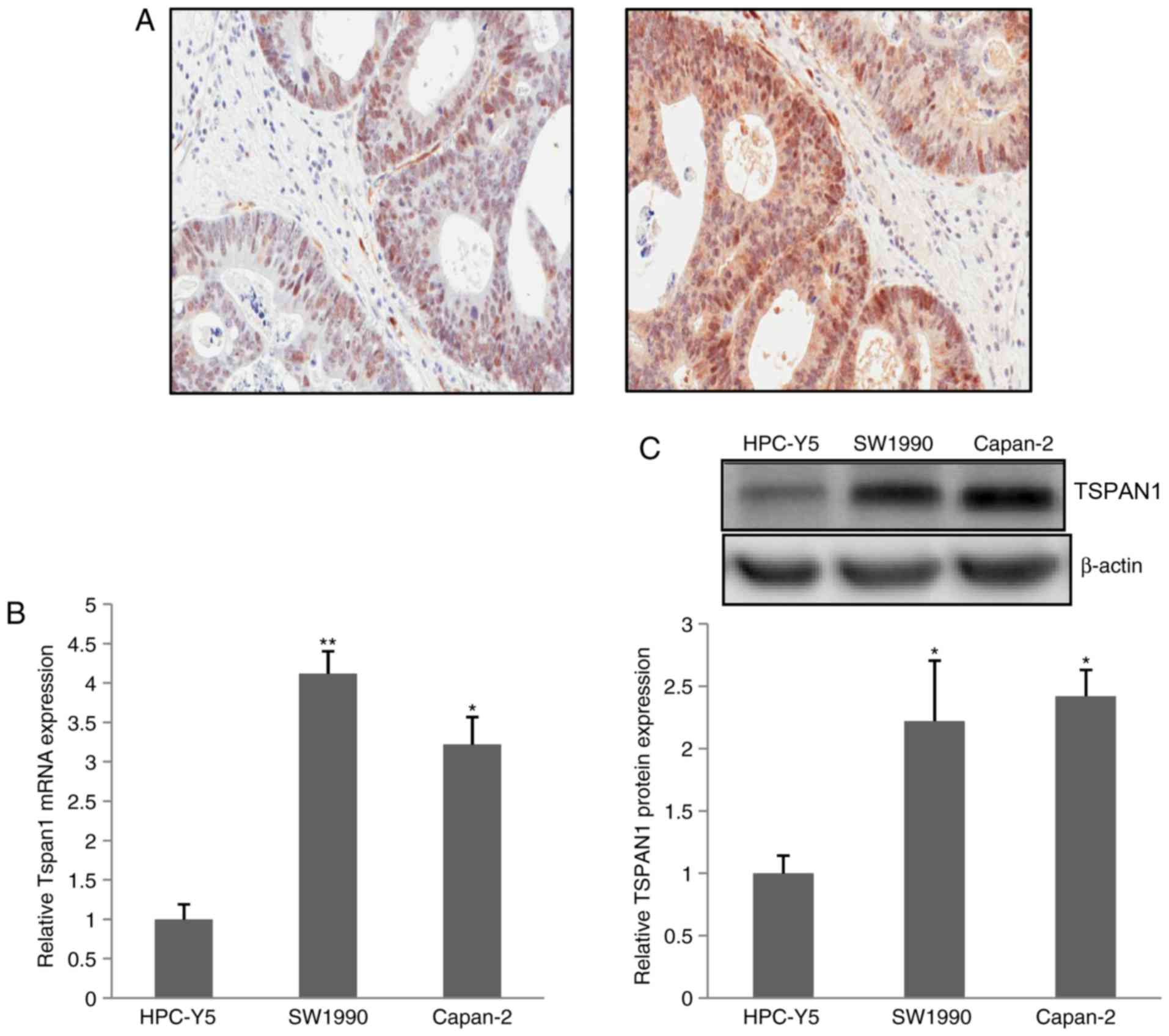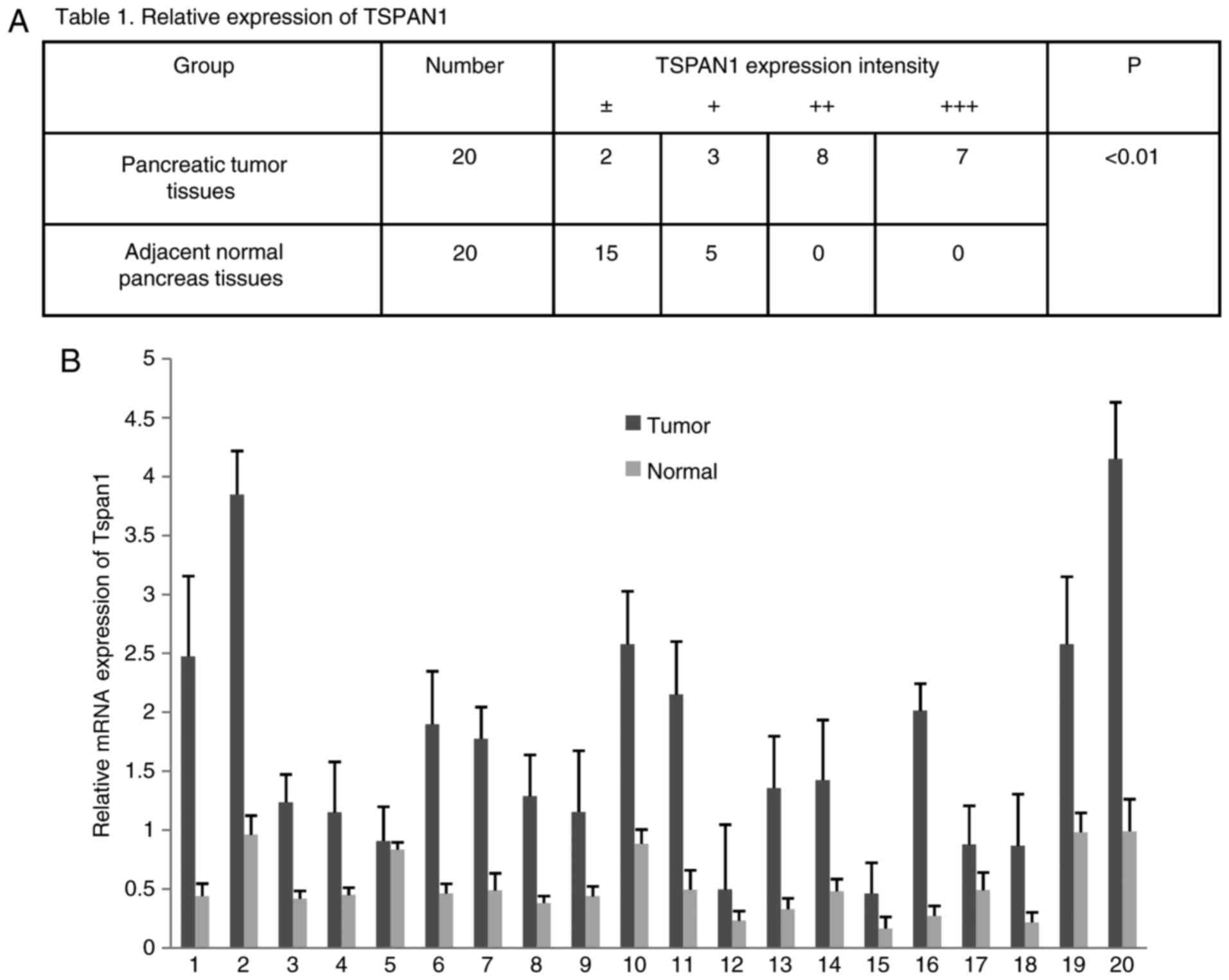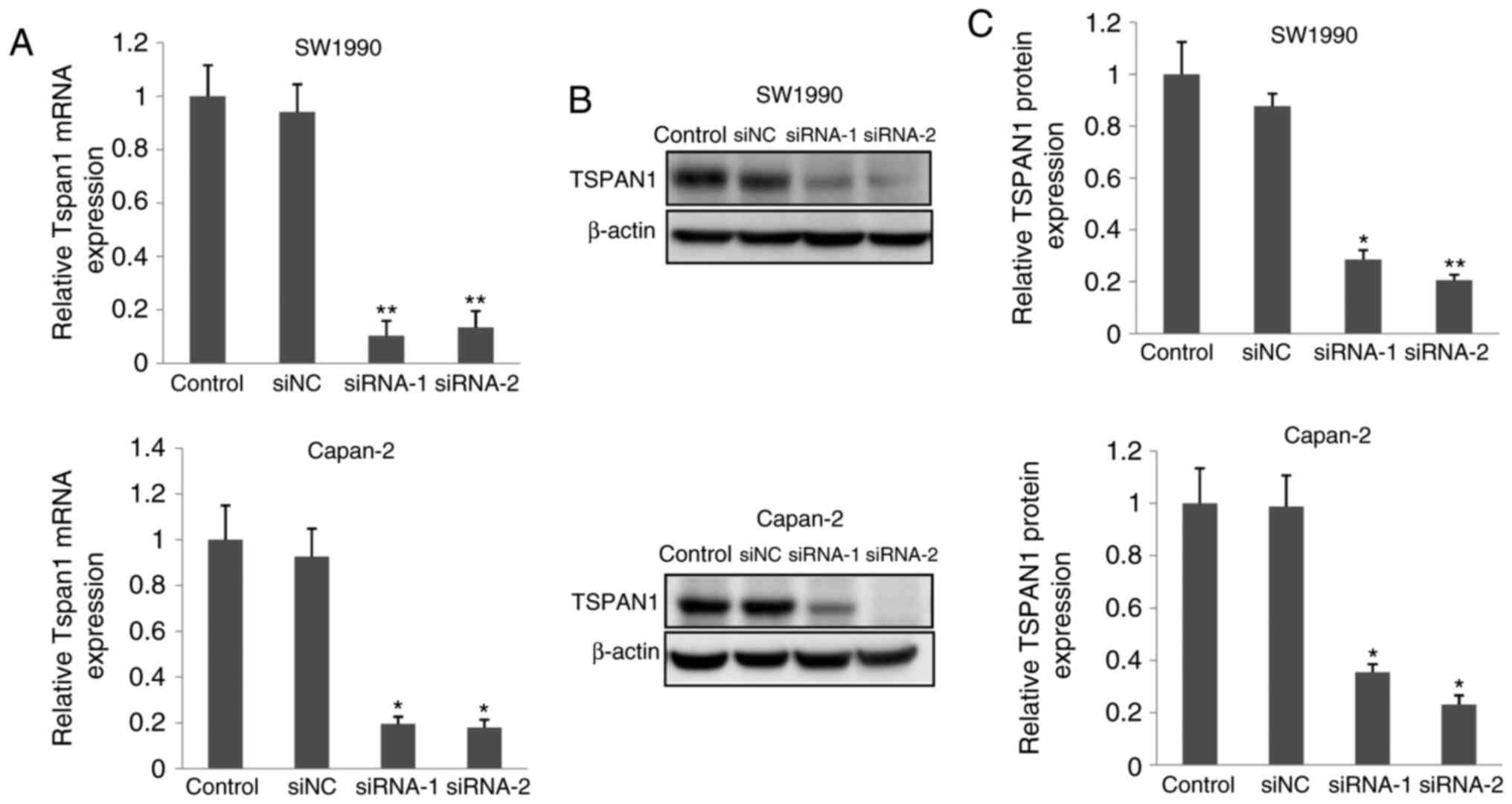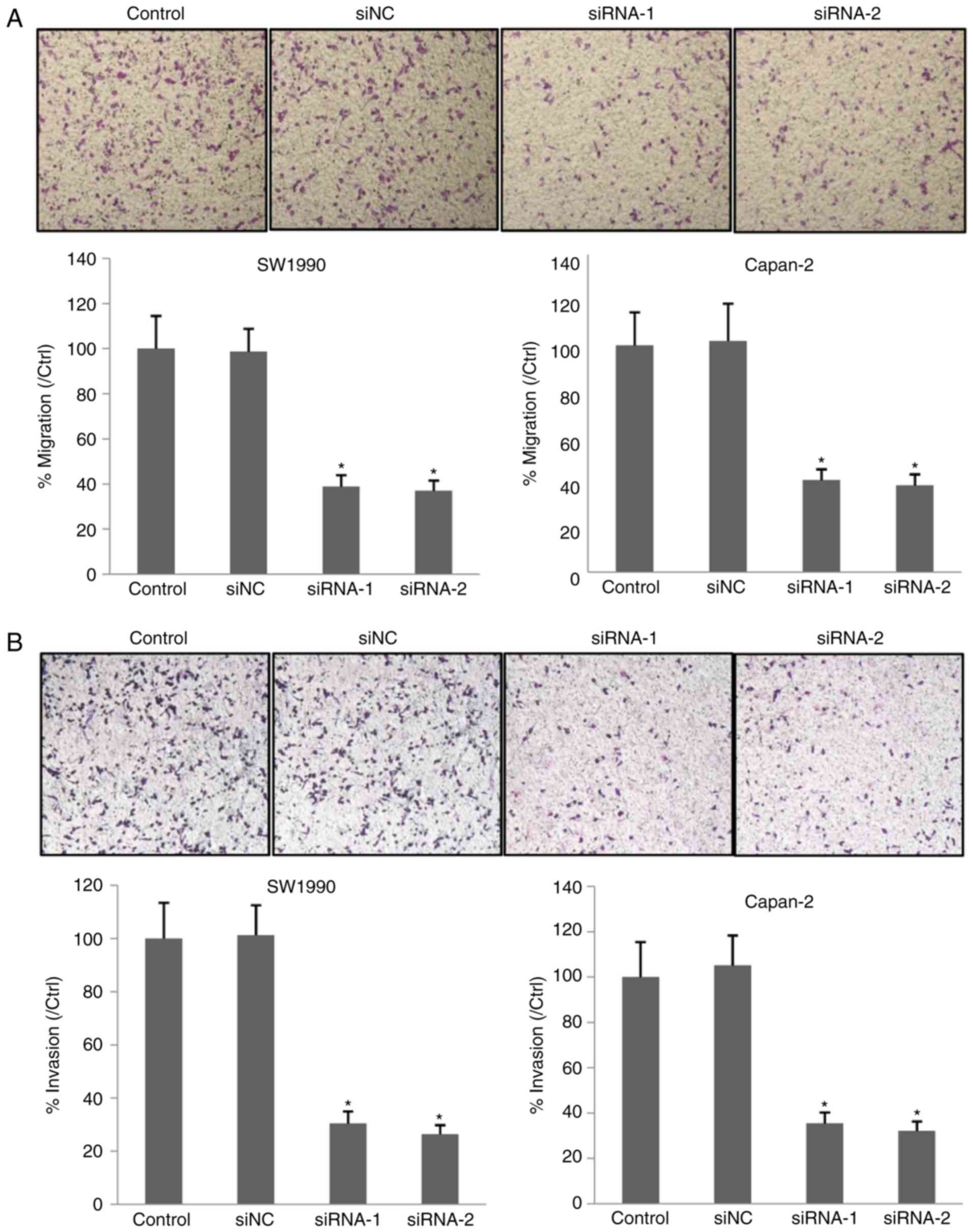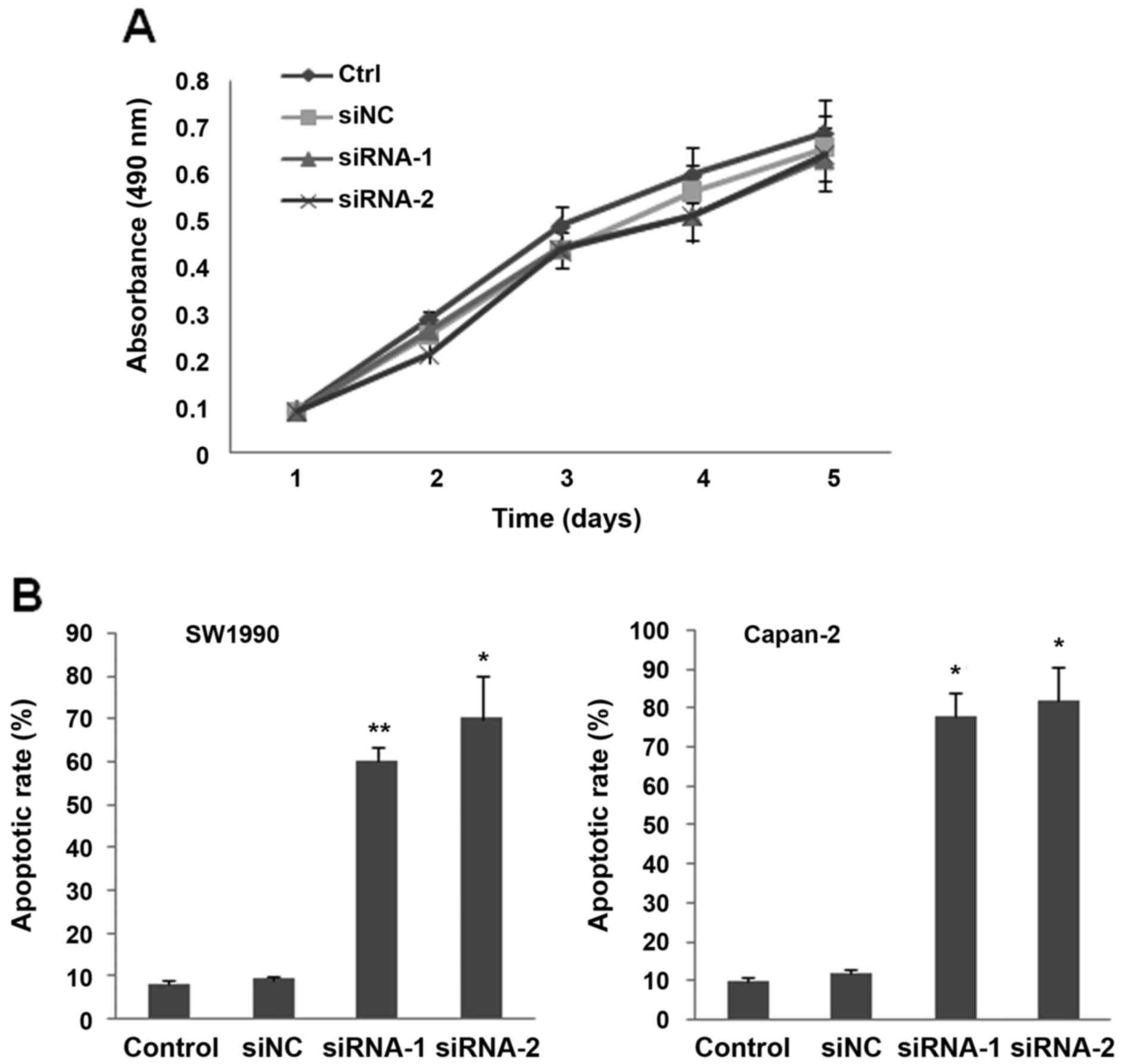|
1
|
Vincent A, Herman J, Schuick R, Hruban RH
and Goggins M: Pancreatic cancer. Lancet. 378:607–620. 2011.
View Article : Google Scholar : PubMed/NCBI
|
|
2
|
Siegel R, Ma J, Zou Z and Jemal A: Cancer
statistics, 2014. CA Cancer J Clin. 64:9–29. 2014. View Article : Google Scholar : PubMed/NCBI
|
|
3
|
Bosetti C, Bertuccio P, Negri E, La
Vecchia C, Zeegers MP and Boffetta P: Pancreatic cancer: Overview
of descriptive epidemiology. Mol Carcinog. 51:3–13. 2012.
View Article : Google Scholar : PubMed/NCBI
|
|
4
|
Loos M, Kleeff J, Friess H and Büchler MW:
Surgical treatment of pancreatic cancer. Ann NY Acad Sci.
1138:169–180. 2008. View Article : Google Scholar : PubMed/NCBI
|
|
5
|
Cascinu S, Berardi R, Labianca R, Siena S,
Falcone A, Aitini E, Barni S, Di Costanzo F, Dapretto E, Tonini G,
et al: Cetuximab plus gemcitabine and cisplatin compared with
gemcitabine and cisplatin alone in patients with advanced
pancreatic cancer: A randomised, multicentre, phase II trial.
Lancet Oncol. 9:39–44. 2008. View Article : Google Scholar : PubMed/NCBI
|
|
6
|
Nakai Y, Isayama H, Sasaki T, Sasahira N,
Tsujino T, Toda N, Kogure H, Matsubara S, Ito Y, Togawa O, et al: A
multicentrer and omised phase II trial of gemcitabine alone vs
gemcitabine and S-1 combination therapy in advanced pancreatic
cancer: GEMSAP study. Br J Cancer. 106:1934–1939. 2012. View Article : Google Scholar : PubMed/NCBI
|
|
7
|
Tuinmann G, Hegewisch-Becker S, Zschaber
R, Kehr A, Schulz J and Hossfeld DK: Gemcitabine and mitomycin C in
advanced pancreatic cancer: A single-institution experience.
Anticancer Drugs. 15:575–579. 2004. View Article : Google Scholar : PubMed/NCBI
|
|
8
|
Hall WA, Colbert LE, Nickleach D,
Switchenko J, Liu Y, Gillespie T, Lipscomb J, Hardy C, Kooby DA,
Prabhu RS, et al: The influence of radiation therapy dose
escalation on overall survival in unresectable pancreatic
adenocarcinoma. J Gastrointest Oncol. 5:77–85. 2014.PubMed/NCBI
|
|
9
|
Veenbergen S and Van Spriel AB:
Tetraspanins in the immune response against cancer. Immunol Lett.
138:129–136. 2011. View Article : Google Scholar : PubMed/NCBI
|
|
10
|
Berditchevski F, Odintsova E, Sawada S and
Gilber E: Expression of the palmitoylation-deficient CD151 weakens
the association of alpha 3 beta 1 integrin with the
tetraspanin-enriched microdomains and affects integrin dependent
signaling. J Biol Chem. 277:36991–37000. 2002. View Article : Google Scholar : PubMed/NCBI
|
|
11
|
Levy S and Shoham T: The tetraspanin web
modulates immune-signalling complexes. Nat Rev Immunol. 5:136–148.
2005. View
Article : Google Scholar : PubMed/NCBI
|
|
12
|
Pedro AL: Functional implications of
tetraspanin proteins in cancer biology. Cancer Sci. 98:1666–1677.
2007. View Article : Google Scholar : PubMed/NCBI
|
|
13
|
Serru V, Dessen P, Boucheix C and
Rubinstein E: Sequence and expression of seven new tetraspans.
Biochim Biophys Acta. 1478:159–163. 2000. View Article : Google Scholar : PubMed/NCBI
|
|
14
|
Scholz CJ, Kurzeder C, Koretz K, Windisch
J, Kreienberg R, Sauer G and Deissler H: Tspan-1 is a tetraspanin
preferentially expressed by mucinous and endometrioid subtypes of
human ovarian carcinomas. Cancer Lett. 275:198–203. 2009.
View Article : Google Scholar : PubMed/NCBI
|
|
15
|
Chen L, Zhu YY, Zhang XJ, Wang GL, Li XY,
He S, Zhang JB and Zhu JW: TSPAN1 protein expression: A significant
prognostic indicator for patients with colorectal adenocarcinoma.
World J Gastroenterol. 15:2270–2276. 2009. View Article : Google Scholar : PubMed/NCBI
|
|
16
|
Chen L, Yuan D, Wang GL, Wang Y, Wu YY and
Zhu J: Clinicopathological significance of expression of Tspan-1,
Jab1 and p27 in human hepatocellular carcinoma. J Korean Med Sci.
25:1438–1442. 2010. View Article : Google Scholar : PubMed/NCBI
|
|
17
|
Chen L, Li X, Wang GL, Wang Y, Zhu YY and
Zhu J: Clinicopathological significance of overexpression of
TSPAN1, Ki67 and CD34 in gastric carcinoma. Tumori. 94:531–538.
2008. View Article : Google Scholar : PubMed/NCBI
|
|
18
|
Wollscheid V, Kühne-Heid R, Stein I,
Jansen L, Köllner S, Schneider A and Dürst M: Identification of a
new proliferation associated protein NET-1/C4.8 characteristic for
a subset of high-grade cervical intraepithelial neoplasia and
cervical carcinomas. Int J Cancer. 99:771–775. 2002. View Article : Google Scholar : PubMed/NCBI
|
|
19
|
Xu J, Stolk JA, Zhang X, Silva SJ,
Houghton RL, Matsumura M, Vedvick TS, Leslie KB, Badaro R and Reed
SG: Identification of differentially expressed genes in human
prostate cancer using subtraction and microarray. Cancer Res.
60:1677–1682. 2000.PubMed/NCBI
|
|
20
|
Liu L, He B, Liu WM, Zhou D, Cox JV and
Zhang XA: Tetraspanin CD151 promotes cell migration by regulating
integrin trafficking. J Biol Chem. 282:31631–31642. 2007.
View Article : Google Scholar : PubMed/NCBI
|
|
21
|
Yamamoto Y, Grubisic K and Oelgeschläger
M: Xenopus tetraspanin-1 regulates gastrulation movements and
neural differentiation in the early xenopus embryo.
Differentiation. 75:235–245. 2007. View Article : Google Scholar : PubMed/NCBI
|
|
22
|
Chen L, Yuan D, Zhao R, Li H and Zhu J:
Suppression of TSPAN1 by RNA interference inhibits proliferation
and invasion of colon cancer cells in vitro. Tumori. 96:744–750.
2010. View Article : Google Scholar : PubMed/NCBI
|
|
23
|
Chen L, Zhu Y, Li H, Wang GL, Wu YY, Lu
YX, Qin J, Tuo J, Wang JL and Zhu J: Knockdown of TSPAN1 by RNA
silencing and antisense technique inhibits proliferation and
infiltration of human skin squamous carcinoma cells. Tumori.
96:289–295. 2010. View Article : Google Scholar : PubMed/NCBI
|
|
24
|
Carlson RW, Hudis CA and Pritchard KI:
Adjuvant endocrine therapy in hormone receptor-positive
postmenopausal breast cancer: Evolution of NCCN, ASCO, and St
Gallen recommendations. J Natl Compr Canc Netw. 4:971–979. 2006.
View Article : Google Scholar : PubMed/NCBI
|
|
25
|
Desouki MM, Liao S, Huang H, Conroy J,
Nowak NJ, Shepherd L, Gaile DP and Geradts J: Identification of
metastasis-associated breast cancer genes using a high-resolution
whole genome profiling approach. J Cancer Res Clin Oncol.
137:795–809. 2011. View Article : Google Scholar : PubMed/NCBI
|
|
26
|
Liu H, Ma Q and Li J: High glucose
promotes cell proliferation and enhances GDNF and RET expression in
pancreatic cancer cells. Mol Cell Biochem. 347:95–101. 2011.
View Article : Google Scholar : PubMed/NCBI
|
|
27
|
Livak KJ and Schmittgen TD: Analysis of
relative gene expression data usingreal-time quantitative PCR and
the 2(-Delta Delta C(T)) method. Methods. 25:402–408. 2001.
View Article : Google Scholar : PubMed/NCBI
|
|
28
|
Albrethsen J, Bøgebo R, Gammeltoft S,
Olsen J, Winther B and Raskov H: Upregulated expression of human
neutrophil peptides 1, 2 and 3 (HNP1-3) in colon cancer serum and
tumours: A biomarker study. BMC Cancer. 5:82005. View Article : Google Scholar : PubMed/NCBI
|
|
29
|
Fei Y, Wang J, Liu W, Zuo H, Qin J, Wang
D, Zeng H and Liu Z: CD151 promotes cancer cell metastasis via
integrins α3 β1 and α6 β1 in vitro. Mol Med Rep. 6:1226–1230. 2012.
View Article : Google Scholar : PubMed/NCBI
|
|
30
|
Takahashi M, Sugiura T, Abe M, Ishii K and
Shirasuna K: Regulation of c-Met signaling by the tetraspanin
KAI-1/CD82 affects cancer cell migration. Int J Cancer.
121:1919–1929. 2007. View Article : Google Scholar : PubMed/NCBI
|
|
31
|
Hölters S, Anacker J, Jansen L,
Beer-Grondke K, Dürst M and Rubio I: Tetraspanin 1 promotes
invasiveness of cervical cancer cells. Int J Oncol. 43:503–512.
2013. View Article : Google Scholar : PubMed/NCBI
|
|
32
|
Lu Z, Luo T, Nie M, Pang T, Zhang X, Shen
X, Ma L1, Bi J, Wei G, Fang G and Xue X: TSPAN1 functions as an
oncogene in gastric cancer and is downregulated by miR-573. FEBS
Lett. 589:1988–1994. 2015. View Article : Google Scholar : PubMed/NCBI
|
|
33
|
Wang H, Rana S, Giese N, Büchler MW and
Zöller M: Tspan8, CD44v6 and alpha6beta4 are biomarkers of
migrating pancreatic cancer-initiating cells. Int J Cancer.
133:416–426. 2013. View Article : Google Scholar : PubMed/NCBI
|
|
34
|
Schmelz M, Cress AE, Scott KM, Bürger F,
Cui H, Sallam K, McDaniel KM, Dalkin BL and Nagle RB: Different
phenotypes in human prostate cancer: Alpha6 or alpha3 integrin in
cell-extra-cellular adhesion sites. Neoplasia. 4:243–254. 2002.
View Article : Google Scholar : PubMed/NCBI
|
|
35
|
Herlevsen M, Schmidt DS, Miyazaki K and
Zöller M: The association of the tetraspanin D6.1A with the
alpha6beta4 integrin supports cell motility and liver metastasis
formation. J Cell Sci. 116:4373–4390. 2003. View Article : Google Scholar : PubMed/NCBI
|
|
36
|
Chen Z, Mustafa T, Trojanowicz B,
Brauckhoff M, Gimm O, Schmutzler C, Köhrle J, Holzhausen HJ, Kehlen
A, Klonisch T, et al: CD82, and CD63 in thyroid cancer. Int J Mol
Med. 14:517–527. 2004.PubMed/NCBI
|















